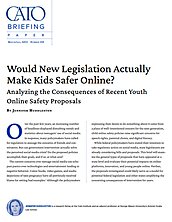1. “Pessimists Archive,” Pessimists Archive; and Melissa S. Kearney and Phillip Levine, “Media Influences on Social Outcomes: The Impact of MTV’s ’16 and Pregnant’ on Teen Childbearing,” Brookings Institution, January 22, 2018.
2. “Texas Bill Would Ban Social Media for Children under 18,” FOX 4 News Dallas-Fort Worth, December 8, 2022; and Jared Gans, “Hawley Proposes Ban on Social Media for Kids under 16,” The Hill, February 15, 2023.
3. Reno v. ACLU, 521 U.S. 844 (June 26, 1997).
4. See Nina Totenberg, “At Supreme Court, Mean Girls Meet 1st Amendment,” NPR, April 28, 2021.
5. American Civil Liberties Union v. Gonzales, 478 F. Supp. 2d 775 (E.D. Pa. March 22, 2007).
6. See Maggie Seaver, “This Is When Kids Are Old Enough to Stay Home Alone, according to Moms (and the Law),” Real Simple, July 29, 2022.
7. “Instagram Teen Annotated Research Deck 1,” DocumentCloud.org.
8. “Instagram Teen Annotated Research Deck 1,” DocumentCloud.org.
9. “Social Media Resume: Skills Employers Look For,” Maryville University (blog), Maryville University.
10. “Special Group on the EU Code of Conduct on Age-Appropriate Design,” Shaping Europe’s Digital Future, European Commission, February 2, 2023; and “Introduction to the Age Appropriate Design Code,” Information Commissioner’s Office.
11. Adi Robertson, “California Passes Sweeping Online Safety Rules for Kids,” The Verge, August 30, 2022.
12. Jackie Snow, “Why Age Verification Is So Difficult for Websites,” Wall Street Journal, February 27, 2022.
13. “Online Age-Verification System Could Create ‘Honeypot’ of Personal Data and Pornography-Viewing Habits, Privacy Groups Warn,” The Guardian, October 30, 2022.
14. Jon Fingas, “UK Bill Would Ban Videos Portraying Channel Immigrant Crossings in a ‘Positive Light,’ ” Engadget, January 19, 2023.
15. “NetChoice v. Bonta,” NetChoice, February 28, 2023.
16. “Liability for Publishers and Distributors of Material Harmful to Minors,” La. Rev. Stat. Ann. § 9:2800.29 (2021).
17. “Obscenity and Indecency: Constitutional Principles and Federal Statutes,” Congressional Research Service, April 28, 2009.
18. “Louisiana’s New Porn Law Carries User Privacy Risks,” NPR, January 8, 2023.
19. Zak Doffman, “Ashley Madison Hack Returns to ‘Haunt’ Its Victims: 32 Million Users Now Watch and Wait,” Forbes, February 1, 2021.
20. Ej Dickson, “Sex Workers Say Reddit Is Quietly Banning Them,” Rolling Stone, August 17, 2022; and Samantha Cole, “Craigslist Just Nuked Its Personal Ads Section because of a Sex-Trafficking Bill,” Vice, March 23, 2018.
21. Tim Cushing, “Louisiana Law Now Requires Age Verification at Any Site Containing More than One-Third Porn,” Techdirt (blog), January 3, 2023.



